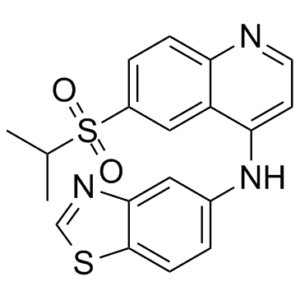GSK’ 872 (GSK2399872A)
This product is for research use only, not for human use. We do not sell to patients.

For small sizes, please check our retail website as below: www.invivochem.com
| Size | Price | Stock |
|---|---|---|
| 100mg | $520 | In Stock |
| 250mg | $920 | In Stock |
| 500mg | $1380 | In Stock |
Cat #: V2773 CAS #: 1346546-69-7 Purity ≥ 98%
Description: GSK'872 (also known as GSK2399872A, GSK872, or GSK-872) is a novel, potent and selective RIPK3 (receptor interacting protein kinase-3) inhibitor. ction to primary hepatocytes.
Top Publications Citing Invivochem Products
Publications Citing InvivoChem Products
Product Promise

- Physicochemical and Storage Information
- Protocol
- Related Biological Data
- Stock Solution Preparation
- Quality Control Documentation
| Molecular Weight (MW) | 383.49 |
|---|---|
| Molecular Formula | C19H17N3O2S2 |
| CAS No. | 1346546-69-7 |
| Storage | -20℃ for 3 years in powder formr |
| -80℃ for 2 years in solvent | |
| Solubility In Vitro | DMSO: 76 mg/mL (198.17 mM)r |
| Water: <1 mg/mLr | |
| Ethanol: 40 mg/mL (104.3 mM) | |
| SMILES Code | O=S(C1=CC=C2N=CC=C(NC3=CC=C(SC=N4)C4=C3)C2=C1)(C(C)C)=O |
| Synonyms | GSK2399872A; GSK872; GSK-872; GSK 872; GSK2399872-A; GSK2399872 A; GSK-2399872A; GSK-2399872 A |
| Protocol | In Vitro | In vitro activity: When assayed at 1 μM, GSK'872 fails to inhibit most of 300 human protein kinases tested. It fails to inhibit RIP1 kinase when tested directly. GSK'872 blocks TNF-induced necroptosis in a concentration-dependent manner in HT-29 cells. In cell-based assays, there is a 100- to 1000-fold shift in the IC50 compared to the cell-free biochemical assays. GSK'872 also blocks necroptosis in primary human neutrophils isolated from whole blood. GSK'872 inhibits TLR3- or DAI-induced death, two RIP1-independent pathways of necroptosis. It induces caspase activation followed by apoptotic cell death Kinase Assay: GSK'872 (also known as GSK2399872A, GSK872, or GSK-872) is a potent and selective RIPK3 (receptor interacting protein kinase-3) inhibitor. It has a high binding affinity to the RIP3 kinase domain with IC50 value of 1.8 nM, and it inhibits the kinase activity with an IC50 of 1.3 nM. Cell Assay: Viability of 3T3-SA cells at 18 h after treatment with TNF in the presence of Z-VAD-fmk in vehicle control (DMSO) or treated with the indicated concentrations of RIP3 kinase inhibitors, GSK'843 or GSK'872 are assayed. |
|---|---|---|
| In Vivo | GSK'872 treatment significantly decreases HIF-1α expression compared with no treatment after ischemia injury in vivo | |
| Animal model | C57BL/6 mice |
These protocols are for reference only. InvivoChem does not
independently validate these methods.
| Solvent volume to be added | Mass (the weight of a compound) | |||
|---|---|---|---|---|
| Mother liquor concentration | 1mg | 5mg | 10mg | 20mg |
| 1mM | 2.6076 mL | 13.0381 mL | 26.0763 mL | 52.1526 mL |
| 5mM | 0.5215 mL | 2.6076 mL | 5.2153 mL | 10.4305 mL |
| 10mM | 0.2608 mL | 1.3038 mL | 2.6076 mL | 5.2153 mL |
| 20mM | 0.1304 mL | 0.6519 mL | 1.3038 mL | 2.6076 mL |
The molarity calculator equation
Mass(g) = Concentration(mol/L) × Volume(L) × Molecular Weight(g/mol)
Mass
=
Concentration
×
Volume
×
Molecular Weight*
The dilution calculator equation
Concentration(start)
×
Volume(start)
=
Concentration(final)
×
Volume(final)
This equation is commonly abbreviated as: C1 V1 = C2 V2
Concentration(start)
C1
×
Volume(start)
V1
=
Concentration(final)
C2
×
Volume(final)
V2
Step One: Enter information below
Dosage mg/kg
Average weight of animals g
Dosing volume per animal µL
Number of animals
Step Two: Enter the in vivo formulation
%DMSO
+
%
+
%Tween 80
+
%ddH2O
Calculation Results:
Working concentration:
mg/ml;
Method for preparing DMSO master liquid:
mg
drug pre-dissolved in
µL
DMSO(Master liquid concentration
mg/mL)
,Please contact us first if the concentration exceeds the DMSO solubility of the batch of drug.
Method for preparing in vivo formulation:
Take
µL
DMSO master liquid, next add
µL
PEG300, mix and clarify, next add
µL
Tween 80,mix and clarify, next add
µL
ddH2O,mix and clarify.
Note:
- (1) Please be sure that the solution is clear before the addition of next solvent. Dissolution methods like vortex, ultrasound or warming and heat may be used to aid dissolving.
- (2) Be sure to add the solvent(s) in order.




































